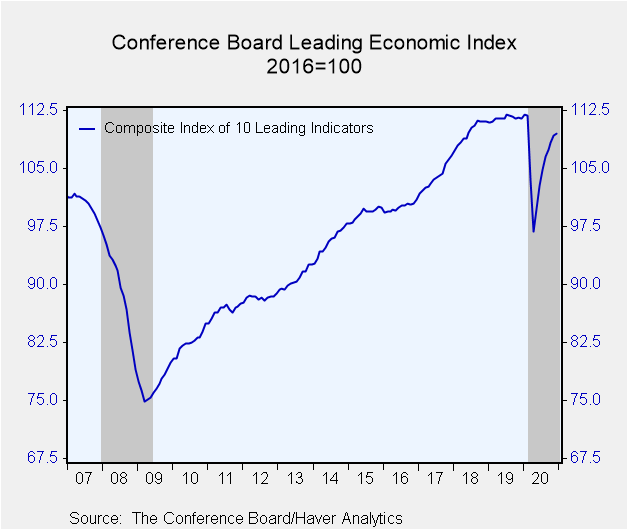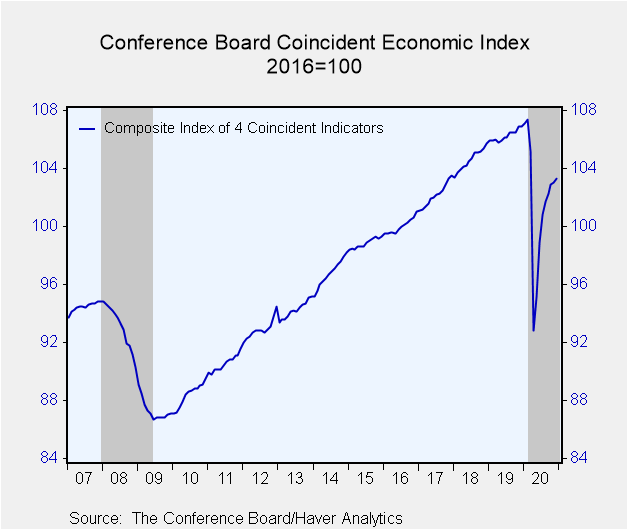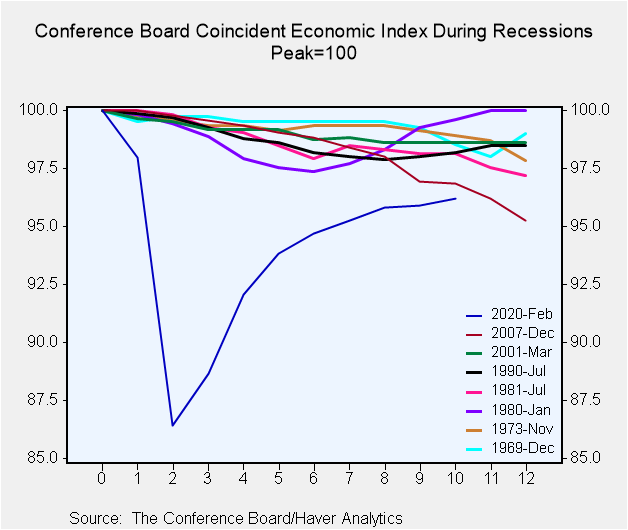 Global| Jan 28 2021
Global| Jan 28 2021U.S. Leading Indicators Decelerate in December
Summary
• Leading index rises 0.3% in December as slowdown from the 0.7% gain in November. • Seven components increase, led by ISM manufacturing new orders. • Three decrease, most notably the contribution from jobless claims. The Conference [...]
• Leading index rises 0.3% in December as slowdown from the 0.7% gain in November.
• Seven components increase, led by ISM manufacturing new orders.
• Three decrease, most notably the contribution from jobless claims.
The Conference Board's Composite Index of Leading Economic Indicators increased 0.3% during December (-1.7% year-on-year) following a slightly upwardly revised 0.7% gain in November (was 0.6%). The Action Economics survey anticipated a 0.5% rise. The Leading Index is comprised of 10 components which tend to precede changes in overall economic activity. Seven of those components contributed positively, led by rising ISM manufacturing new orders. A jump in weekly jobless claims, which was indicative of the job loss experienced in December, was the most notable of the three components with negative contributions. Given the dependence of the economy on the progression of COVID-19, the normally forward-looking measures of the Leading Index are less telling.
The Index of Coincident Economic Indicators also increased 0.3% in December (-3.6% y/y), following a downwardly revised 0.1% gain in November (was 0.2%). This puts the Q4 average of the coincident index 5.9% annualized above the Q3 average. In contrast, as reported earlier this morning, GDP grew at a 4.0% annual rate in Q4. Even with its rebound in the last eight months, the coincident index in December was still down 3.8% from its February peak. Three out of the four component series of the coincident measure increased, led by industrial production. Meanwhile, the decline in payroll employment was a drag.
The Conference Board figures are available in Haver's BCI database; the components are available there, and most are also in USECON. The expectations are in the AS1REPNA database. Visit the Conference Board's site for coverage of leading indicator series from around the world.
| Business Cycle Indicators (%) | Dec | Nov | Oct | Dec Y/Y | 2020 | 2019 | 2018 |
|---|---|---|---|---|---|---|---|
| Leading | 0.3 | 0.7 | 0.9 | -1.7 | -4.9 | 1.6 | 5.7 |
| Coincident | 0.3 | 0.1 | 0.6 | -3.6 | -4.4 | 1.8 | 2.5 |
| Lagging | 0.1 | 0.1 | 0.2 | -1.0 | 1.3 | 2.8 | 2.5 |
Gerald D. Cohen
AuthorMore in Author Profile »Gerald Cohen provides strategic vision and leadership of the translational economic research and policy initiatives at the Kenan Institute of Private Enterprise.
He has worked in both the public and private sectors focusing on the intersection between financial markets and economic fundamentals. He was a Senior Economist at Haver Analytics from January 2019 to February 2021. During the Obama Administration Gerald was Deputy Assistant Secretary for Macroeconomic Analysis at the U.S. Department of Treasury where he helped formulate and evaluate the impact of policy proposals on the U.S. economy. Prior to Treasury, he co-managed a global macro fund at Ziff Brothers Investments.
Gerald holds a bachelor’s of science from the Massachusetts Institute of Technology and a Ph.D. in Economics from Harvard University and is a contributing author to 30-Second Money as well as a co-author of Political Cycles and the Macroeconomy.









